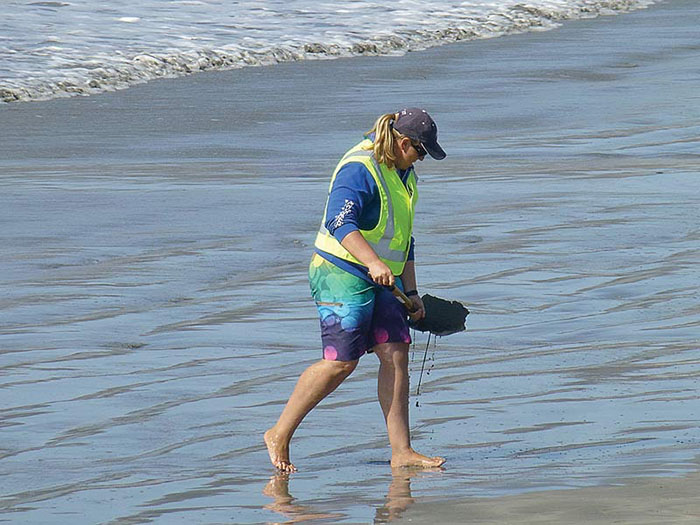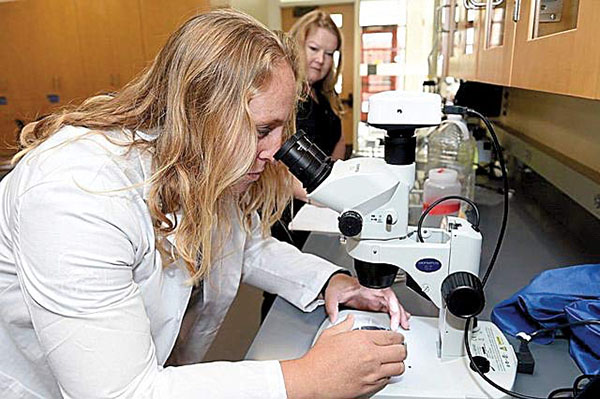 Feb. 20, 2020 — Research conducted by CSU Channel Islands (CSUCI) 2016 graduate Dorothy Horn and her mentor, Assistant Professor of Environmental Science & Resource Management (ESRM) Clare Steele, Ph.D. showed microplastics in sand crabs on the California coast.
Feb. 20, 2020 — Research conducted by CSU Channel Islands (CSUCI) 2016 graduate Dorothy Horn and her mentor, Assistant Professor of Environmental Science & Resource Management (ESRM) Clare Steele, Ph.D. showed microplastics in sand crabs on the California coast.
The next phase of their research, conducted after Horn graduated, showed that the microplastics are affecting how long the sand crabs live, and how well they can reproduce.
These results from these roughly 20 millimeter creatures at the lower end of the food chain are raising a red flag for those of us at the top of the food chain.
“These are the main critters that live on the sand and they’re really important because the fish eat them, the shore birds and otters eat them and on up the food chain,” Horn said. “Every ecosystem is like a Jenga puzzle. You might be able to pull out a few blocks and it looks OK, but you pull out another block and the whole puzzle crumbles.”
Exactly how the microplastics in the food chain affect humans is still being studied, but Horn said others researching microplastics have found microplastics in human feces and the tiniest fibers have even been found in human lung tissue.
Steele and Horn began their research into microplastics and sand crabs when Horn was an undergraduate ESRM major at CSUCI. Horn dissected about 300 sand crabs from coasts stretching from Alaska to San Diego and found microplastics in about 35% of them. In the meantime, Steele tested sediment from 51 beaches up and down the California coast. Microplastics were present in every one of 51 beaches sampled.
After Horn graduated in 2016, she entered Portland State University (PSU) to pursue her doctorate in marine ecology. Then, she received a National Science Foundation Graduate Research Fellowship to continue her research into microplastics.
Horn and Steele then collaborated to develop a way to examine how microplastics affected the crabs, if at all.
“We incubated crabs in their reproductive cycle with and without plastics,” Steele said “I was involved in the design and she did the implementation.”
The research showed that adult crabs die sooner when they are exposed to polypropylene microfibers, and crabs carrying eggs tend to release them too early, causing them to die. The microplastics also caused the length of the embryonic crab’s life to vary — either staying in the embryonic stage to long or too short a time.
As is true with most research, the results raised more questions that need answers, so Horn plans to conduct more research to help educate scientists and the public about what microplastics are doing to our sea life and therefore, to us.
 “The good part is, the more we’re finding out, the more it pushes policy,” Horn said. “There are plastics in bottled drinking water, for example, and California has passed a law that we measure that amount. All of this brings more money into the research field so we can find out.”
“The good part is, the more we’re finding out, the more it pushes policy,” Horn said. “There are plastics in bottled drinking water, for example, and California has passed a law that we measure that amount. All of this brings more money into the research field so we can find out.”
Steele considers Horn one of the “superstars” of the ESRM program, adding that as an educator, it thrills her to see a student like Horn make such an impact in her field.
“It makes me feel like all the hard work we put into the undergraduate research we do is worth it,” Steele said. “To be able to expose them to a potential career and then have the opportunity to work with them as a colleague — I’m really stoked.”
The study's findings were recently published in the journal Limnology and Oceanography Letters. Besides Steele, Horn's coauthors included Elise Granek, Ph.D., a professor of environmental science and management at PSU.
